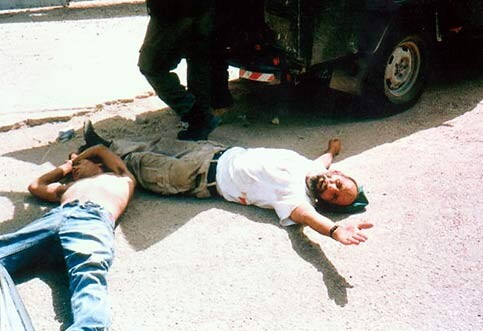Arab Association for Human Rights (HRA) 4 October 2004

The cover of the latest report produced by the Arab Association for Human Rights (HRA), based in Nazareth, shows a photograph of Saleh Suleiman Amer, aged 50, lying on the road next to a Border Police jeep, a bleeding wound to his leg and his arm out-stretched as though pleading to the photographer for help. His 27-year-old son Shadi lies still on the ground, his shirt removed, his hands cuffed, and his body showing signs of a severe beating.
This is just one of the shocking images that illustrates the HRA’s report “Four Years On”, a study of continuing police brutality directed at the country’s Palestinian Arab minority four years after the security forces shot dead 12 unarmed Palestinian Arab citizens and one labourer from Gaza during protests at the outset of the intifada, and one year since the Or Commission, which investigated those events, warned that deep-seated racism was rife throughout the police force.
In his report, Justice Theodor Or concluded that police attitudes must be overhauled as a matter of urgency. “It is important to act in order to uproot phenomena of negative prejudices that have been found regarding the Arab sector, even among veteran and esteemed officers. The police must inculcate among its personnel the understanding that the Arab public as a whole is not their enemy, and that it is not to be treated as the enemy.”
However, as the HRA report shows, police attitudes are unchanged and there are even signs that the police are more racist, hostile and aggressive than ever. Some 16 Palestinian citizens have been shot dead since the October 2000 events by the police forces.
Justice Or also criticised the failure of the Police Investigations Unit (Mahash) to investigate the 13 deaths at the start of the intifada. Similar failures, however, continue to this day. In 2003, there were 6,000 complaints of police brutality, of which only a quarter were investigated. One in 100 of those complaints (58) led to indictments and a further 119 officers were disciplined.
The HRA has investigated 10 instances of police brutality against Palestinian Arab citizens in the year since Justice Or published his findings. We present in our report four of those cases, which we have selected as a representative sample.
The most shocking case concerns an incident in Kafr Qasem in September 2003 when Border Police entered a garage workshop in search of a stolen vehicle. When they failed to find it, they beat one of the staff, Shadi Amer. A friend who came to his defence was attacked too and chased by a policeman who fired live rounds at him. When Shadi tried to escape he was also shot at with live ammunition. After he was caught, he was handcuffed and beaten in the back of a police jeep. His father arrived at the scene and, while he was holding Shadi, was shot in the leg. The officers then beat Shadi repeatedly until he was barely conscious. At that point, he heard one say: “I think he’s dead, let’s go.” Shadi was left in the street. He was only arrested when he arrived at hospital, after a passing car took him there. The testimony of Shadi, his father and others is supported by photographs taken by an eye witness.
In another case, which took place in Tel Aviv in November 2003, a policeman from a special undercover unit claimed to believe Imad Suleiman was aiding a thief. The policeman turned abusive and, when Imad remonstrated with him and tried to call the ordinary police, the officer called for backup. Imad and his passenger were arrested, beaten severely in the back of the police vehicles and then taken to a police station. There they endured several hours of beatings. When it became clear that the men were innocent, they were released after being threatened with death if they filed a complaint.

Four Border Policemen stand with their fingers on the triggers of
their guns, ready to shoot, in the Israeli city of Kafr Qasem.
A pattern is discernible in each of the cases reported by the HRA. On each occasion, the officers were aware that the suspects they were dealing with were Arabs: one was seen leaving a mosque; another was on the way to pray early in the morning wearing a keffiyeh; another was overheard speaking Arabic.
The physical violence began after the suspects began remonstrating with the police officers or asserted their legal rights to fair treatment. This violence was accompanied by verbal attacks, which reflected a profound degree of racism on the part of the officers. Shadi was called “a sonofabitch” when he argued that he was an Israeli citizen. Among other curses, Imad was called “trash”, “scum” and an “Arab criminal”. At another point, he was told: “You’re an Arab and you’re going to tell me what to do? I’ll show you what I’ll do” and later still: “We don’t need a filthy Arab to donate to our synagogue.”
The cases documented by the HRA are typical of a larger sample of incidents we have investigated and yet more which have been reported by the Israeli media. The policy of the Police Investigations Unit, part of the Ministry of Justice, appears to be not to prosecute police involved in attacks on Arabs or to postpone prosecutions until it becomes difficult to prove the details of the case or to identify the officers involved.
The HRA recommends that all police personnel be given educational programs to discourage racist attitudes inside the force, that incidents of alleged beatings be properly investigated and that police officers suspected of using unlawful force be suspended during those investigations.
Related Links
For further information, please contact us directly:
Muhammad Zeidan, Director
Arab Association for Human Rights (HRA)
PO Box 215, Nazareth 16101, Israel
telephone: +972 (0)4 6561923
fax: +972 (0)4 6564934
web: www.arabhra.org